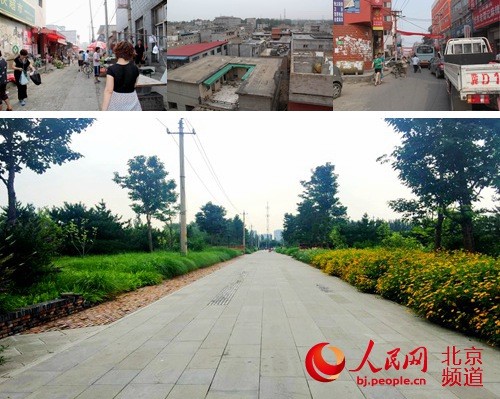


Photo shows a comparison of Tangjialing Village in Beijing. The past view of Tangjialing Village.(above)Tangjialing’s present.(below)(People's Daily Online/Meng Zhu)
China has been slum-free since the founding of the People's Republic of China 70 years ago.
Some may assume that city villages are slums because they are also places where low-income residents live. However, Chinese villages are different from slums in other countries in various ways.
First of all, slums are formed in the process of fast urbanization and industrialization when rural residents flood cities and voluntarily and illegally built clusters of houses.
People in city villages used to live in the suburbs rather than the urban centers. However, because of city expansion, their villages naturally became a part of the growing city.
According to Li Tie, an urban development economist, as the city kept expanding, the demand for land grew. In this process, the farmer's collective-owned rural land inevitably became state-owned urban land.
Slums are crowded and suffer low sanitation coverage, and people there live in poverty. Meanwhile, administration is inadequate because the governments often neglect the areas or are unwilling to improve them through proper management. As a result, slums often become a hotbed of crime.
The city villages in China are safe and legal. Besides, Chinese governments at all levels have made efforts to improve the living environment of city villagers.
China's city villages are village-based, which means communities are managed collectively. In this case, they won't expand more than they should, said Li.
In addition, the migrant population flow is driven by employment, while in some developing and developed countries, slum dwellers often suffer unemployment and extreme poverty, Li added.
China, while promoting urbanization, has integrated city village development into urbanization. As a result, city villages have become much more livable.
Official data indicated that 59.58 percent of Chinese people were urban residents by the end of 2018, up 48.94 percentage points from 1949.
There is indeed a large migrant population in Chinese cities, who are underprivileged compared with urban residents.
To uplift the living conditions of these people, China has rolled out the shantytown renovation project. Meanwhile, it also places great importance on providing housing to middle- and low-income households by developing the public rental housing sector.
More than 80 million units of government-subsidized housing have been built, helping over 200 million people with their housing problems, forming the world's most extensive housing security system, said Wang Menghui, minister of Housing and Urban-Rural Development.
 Fire brigade in Shanghai holds group wedding
Fire brigade in Shanghai holds group wedding Tourists enjoy ice sculptures in Datan Town, north China
Tourists enjoy ice sculptures in Datan Town, north China Sunset scenery of Dayan Pagoda in Xi'an
Sunset scenery of Dayan Pagoda in Xi'an Tourists have fun at scenic spot in Nanlong Town, NW China
Tourists have fun at scenic spot in Nanlong Town, NW China Harbin attracts tourists by making best use of ice in winter
Harbin attracts tourists by making best use of ice in winter In pics: FIS Alpine Ski Women's World Cup Slalom
In pics: FIS Alpine Ski Women's World Cup Slalom Black-necked cranes rest at reservoir in Lhunzhub County, Lhasa
Black-necked cranes rest at reservoir in Lhunzhub County, Lhasa China's FAST telescope will be available to foreign scientists in April
China's FAST telescope will be available to foreign scientists in April "She power" plays indispensable role in poverty alleviation
"She power" plays indispensable role in poverty alleviation Top 10 world news events of People's Daily in 2020
Top 10 world news events of People's Daily in 2020 Top 10 China news events of People's Daily in 2020
Top 10 China news events of People's Daily in 2020 Top 10 media buzzwords of 2020
Top 10 media buzzwords of 2020 Year-ender:10 major tourism stories of 2020
Year-ender:10 major tourism stories of 2020 No interference in Venezuelan issues
No interference in Venezuelan issues
 Biz prepares for trade spat
Biz prepares for trade spat
 Broadcasting Continent
Broadcasting Continent Australia wins Chinese CEOs as US loses
Australia wins Chinese CEOs as US loses